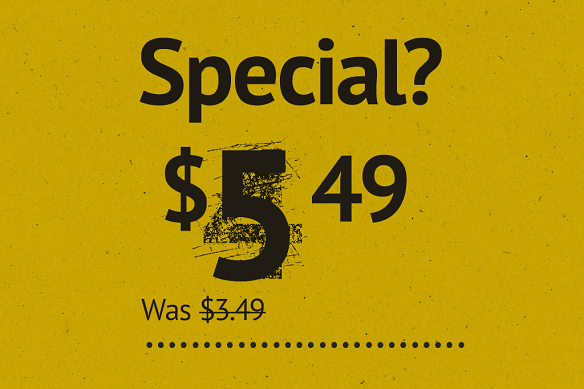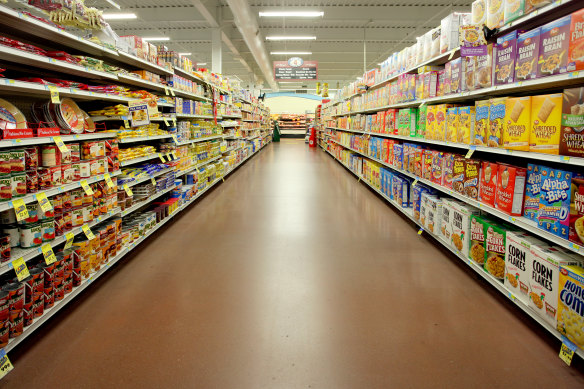
Emma Easton, a strategist at retail consultancy firm RetailOasis, says shrinkflation – where a good’s size gets smaller but the price stays the same – is another tactic supermarkets have been using for years.
“Shrinkflation really is another form of hidden inflation. The actual size of the product is reducing. However, the price remains the same,” she said.
In Spain, the competition watchdog has required supermarkets to tell shoppers if the size or price of a product has changed.
Tags designed to look like there’s a sale
At a glance in a supermarket aisle, brightly coloured tags displaying phrases such as “down, down” or “prices dropped” can create the impression that the items are on special.
Consumer group Choice says consumers are likely to rely on these claims to indicate a product is discounted, but in reality there is no sale.

ACCC is taking action against Coles and Woolworths’ pricing strategies.Credit: Nine
A Woolworths spokesperson said the company worked hard to comply with consumer laws and to communicate its prices clearly.
“Prices Dropped and Lower Prices are about driving longer-term consistent value to our customers and are not a short-term sale or special,” they said.
Even so, Jiang says these are deliberate tactics.
“The psychology behind this is that the consumers are heavily influenced by the discount offered. So when you go into the supermarket, your attention will be drawn to the yellow stickers because it says this product is on discount,” she said.
Jiang also says this behaviour spoils customers’ trust in brands, and could push shoppers to go elsewhere for their groceries.
Loading
In Roy Morgan’s annual Australian brand trust indicator, Woolworths plummeted from second most trusted brand last year to 34th in 2024.
Coles was ranked fifth most trusted brand last year; now it has fallen to the ninth most mistrusted brand. Budget German competitor Aldi has jumped to third overall most trusted Australian brand.
Easton from RetailOasis says supermarkets make billions of dollars in profits every year, but their margins are slim due to high operating costs, so they are often reliant on sneaky sales to boost their bottom lines. She says they’ve faced rising costs from wages and transport at the same time as consumers have become more price-sensitive.
“The supermarkets are in a bit of a position where the margins are shrinking, the prices are increasing, but the consumer needs value, really to survive, and they really want to be buying value,” she said.
Store layouts
A more subtle technique designed to get shoppers spending more is the store layout. Having the essentials such as fresh produce at the front, often followed by bread and milk as you walk further into the store, means shoppers feel accomplished after grabbing their necessities.
The goal after this is for consumers to “treat themselves” as they walk past different aisles such as the lollies, chips or soft drink aisle, before completing the trip through the pantry necessities and the bin liner aisle.
Choice senior policy and campaigns adviser Bea Sherwood says that tactic speaks to how grocers use supermarket psychology.

Sales are deliberately stuck on the end of aisles as shoppers don’t all go up and down each aisle. Credit: Getty
“The way they place specials or discounted items at the end of aisles, they know that people might not always go up the aisles – even down to the colours that they use,” she said.
“If they make a product green, it triggers something in people’s brains to think that it’s more environmentally friendly, even if it doesn’t explicitly say it. Or using like black and gold, kind of alludes to a more luxury item brand, so they’re more inclined to spend more money on that.”
Was/now claims or “illusory discounts”
This is what has landed Coles and Woolworths in hot water with the competition watchdog.
Easton says “price perception manipulation” is a tactic that uses was/now prices to create the impression of a discount.
“They’re artificially inflating prices for a very short period of time and then promoting it straight away afterwards, and making out of it as some big sale where, in most cases, it’s actually more expensive than the original price,” she said.
“The supermarkets will try to pull the wool over the consumer’s eyes, so consumers think they’re getting a deal and are still happy with the prices.”
Coles said it would fight the ACCC’s case. Woolworths has not committed to defending the proceedings.



























